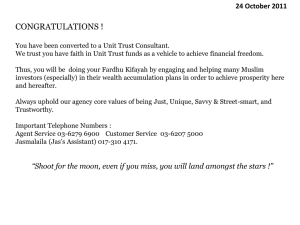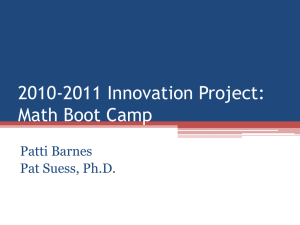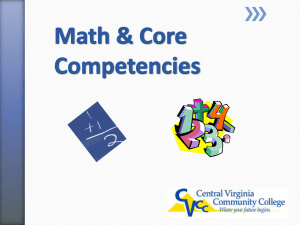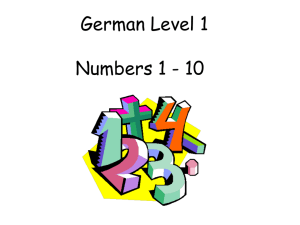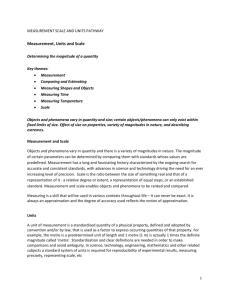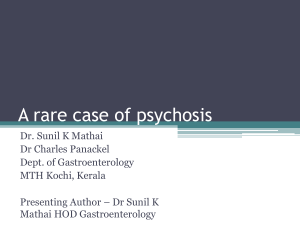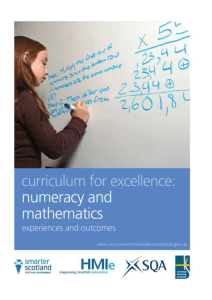Number, Money
advertisement
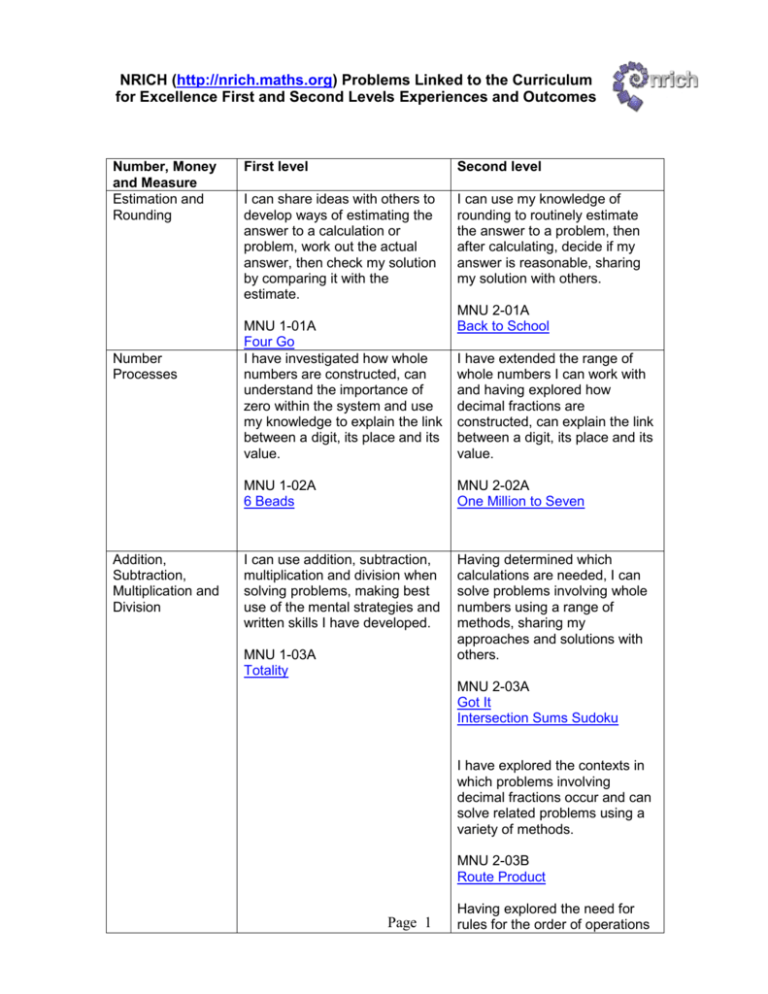
NRICH (http://nrich.maths.org) Problems Linked to the Curriculum for Excellence First and Second Levels Experiences and Outcomes Number, Money and Measure Estimation and Rounding Number Processes Addition, Subtraction, Multiplication and Division First level Second level I can share ideas with others to develop ways of estimating the answer to a calculation or problem, work out the actual answer, then check my solution by comparing it with the estimate. I can use my knowledge of rounding to routinely estimate the answer to a problem, then after calculating, decide if my answer is reasonable, sharing my solution with others. MNU 1-01A Four Go I have investigated how whole numbers are constructed, can understand the importance of zero within the system and use my knowledge to explain the link between a digit, its place and its value. MNU 2-01A Back to School I have extended the range of whole numbers I can work with and having explored how decimal fractions are constructed, can explain the link between a digit, its place and its value. MNU 1-02A 6 Beads MNU 2-02A One Million to Seven I can use addition, subtraction, multiplication and division when solving problems, making best use of the mental strategies and written skills I have developed. Having determined which calculations are needed, I can solve problems involving whole numbers using a range of methods, sharing my approaches and solutions with others. MNU 1-03A Totality MNU 2-03A Got It Intersection Sums Sudoku I have explored the contexts in which problems involving decimal fractions occur and can solve related problems using a variety of methods. MNU 2-03B Route Product Page 1 Having explored the need for rules for the order of operations in number calculations, I can apply them correctly when solving simple problems. MTH 2-03C Magic Potting Sheds I can show my understanding of how the number line extends to include numbers less than zero and have investigated how these numbers occur and are used. Negative Numbers MNU 2-04A First Connect Three Consecutive Numbers Having explored the patterns and relationships in multiplication and division, I can investigate and identify the multiples and factors of numbers. Multiples, Factors and Primes Fractions, Decimals and Percentages Having explored fractions by taking part in practical activities, I can show my understanding of: • how a single item can be shared equally • the notation and vocabulary associated with fractions • where simple fractions lie on the number line. MNU1-07A Same Shapes Through exploring how groups of items can be shared equally, I can find a fraction of an amount by applying my knowledge of division. MNU1-07B Chocolate Bars Through taking part in practical activities including use of pictorial representations, I can Page 2 MTH 2-05A Factors and Multiples Game Factors and Multiples Puzzle I have investigated the everyday contexts in which simple fractions, percentages or decimal fractions are used and can carry out the necessary calculations to solve related problems. MNU 2-07A 100 Percent I can show the equivalent forms of simple fractions, decimal fractions and percentages and can choose my preferred form when solving a problem, explaining my choice of method. MNU 2-07B Matching Fractions Decimals Percentages I have investigated how a set of equivalent fractions can be created, understanding the demonstrate my understanding of simple fractions which are equivalent. MTH 1-07C Adapted simpler version of Fractions Jigsaw Money I can use money to pay for items and can work out how much change I should receive. MNU 1-09A The Puzzling Sweet Shop I have investigated how different combinations of coins and notes can be used to pay for goods or be given in change. MNU 1-09B Five Coins meaning of simplest form, and can apply my knowledge to compare and order the most commonly used fractions. MTH 2-07C Fractions Jigsaw Dark Blue Light Blue I can manage money, compare costs from different retailers, and determine what I can afford to buy. MNU 2-09A The Money Maze Are You a Smart Shopper? I understand the costs, benefits and risks of using bank cards to purchase goods or obtain cash and realise that budgeting is important. MNU 2-09B I can use the terms profit and loss in buying and selling activities and can make simple calculations for this. Time I can tell the time using 12 and 24 hour clocks, explain how it impacts on my daily routine and ensure that I am organised and ready for events throughout my day. MNU 2-09C I can use and interpret electronic and paper-based timetables and schedules to plan events and activities, and make time calculations as part of my planning. MNU 1-10A Two Clocks MNU 2-10A Stop the Clock I can use a calendar to plan and be organised for key events for myself and my class throughout the year. I can carry out practical tasks and investigations involving timed events and can explain which unit of time would be most Page 3 appropriate to use. MNU 1-10B Calendar Cubes Measurement MNU 2-10B Having the Time of Your Life I have begun to develop a sense Using simple time periods, I can of how long tasks take by give a good estimate of how measuring the time taken to long a journey should take, complete a range of activities based on my knowledge of the using a variety of timers. link between time, speed and distance. MNU 1-10C MNU 2-10C Gr8 Coach Take Your Dog for a Walk I can estimate how long or I can use my knowledge of the heavy an object is, or what sizes of familiar objects or amount it holds, using everyday places to assist me when things as a guide, then measure making an estimate of measure. or weigh it using appropriate instruments and units. MNU 2-11A All in a Jumble MNU 1-11A At the Pumps Do You Measure Up? I can use the common units of measure, convert between I can estimate the area of a related units of the metric shape by counting squares or system and carry out other methods. calculations when solving problems. MNU 1-11B Fencing MNU 2-11B Thousands and Millions I can explain how different methods can be used to find the perimeter and area of a simple 2D shape or volume of a simple 3D object. MNU 2-11C Smaller and Smaller Page 4 Mathematics – its Impact on the World, Past, Present and Future Patterns and Relationships I have discussed the important part that numbers play in the world and explored a variety of systems that have been used by civilisations throughout history to record numbers. I have worked with others to explore, and present our findings on, how mathematics impacts on the world and the important part it has played in advances and inventions. MTH 1-12A Which Scripts? MTH 2-12A Code Breaker I can continue and devise more involved repeating patterns or designs, using a variety of media. Having explored more complex number sequences, including well-known named number patterns, I can explain the rule used to generate the sequence, and apply it to extend the pattern. MTH 1-13A Through exploring number patterns, I can recognise and continue simple number sequences and can explain the rule I’ve applied. Expressions and Equations MTH 1-13B I can compare, describe and show number relationships, using appropriate vocabulary and the symbols for equals, not equal to, less than and greater than. MTH 1-15A One to Fifteen When a picture or symbol is used to replace a number in a number statement, I can find its value using my knowledge of number facts and explain my thinking to others. MTH 1-15B Secret Number Getting the Balance Page 5 MTH 2-13A 1 Step 2 Step I can apply my knowledge of number facts to solve problems where an unknown value is represented by a symbol or letter. MTH 2-15A Shape Times Shape What’s it Worth? Shape, Position and Movement Properties of 2D Shapes and 3D Objects I have explored simple 3D objects and 2D shapes and can identify, name and describe their features using appropriate vocabulary. MTH 1-16A Where Are They? Having explored a range of 3D objects and 2D shapes, I can use mathematical language to describe their properties, and through investigation can discuss where and why particular shapes are used in the environment. I can explore and discuss how and why different shapes fit together and create a tiling pattern with them. MTH 2-16A Building Stars Lafayette Through practical activities, I can show my understanding of the relationship between 3D objects and their nets. MTH 1-16B Repeating Patterns Semi-regular Tessellations MTH 2-16B Triangular Faces I can draw 2D shapes and make representations of 3D objects using an appropriate range of methods and efficient use of resources. Angle, Symmetry and Transformation I can describe, follow and record routes and journeys using signs, words and angles and associated with direction and turning. MTH 1-17A MTH 2-16C The Third Dimension I have investigated angles in the environment, and can discuss, describe and classify angles using appropriate mathematical vocabulary. MTH 2-17A Nine-pin Triangles I can accurately measure and draw angles using appropriate equipment, applying my skills to problems in context. MTH 2-17B A Patchwork Piece Take the Right Angle Through practical activities, Page 6 which include the use of technology, I have developed my understanding of the link between compass points and angles and can describe, follow and record directions, routes and journeys using appropriate vocabulary. MTH 2-17C Six Places to Visit Having investigated where, why and how scale is used and expressed, I can apply my understanding to interpret simple models, maps and plans. MTH 2-17D I have developed an awareness of where grid reference systems are used in everyday contexts and can use them to locate and describe position. I can use my knowledge of the co-ordinate system to plot and describe the location of a point on a grid. MTH 2-18A Coordinate Cunning Ten Hidden Squares MTH 1-18A Criss Cross Quiz I have explored symmetry in my own and the wider environment and can create and recognise symmetrical pictures, patterns and shapes. MTH 1-19A Watch Those Wheels I can illustrate the lines of symmetry for a range of 2D shapes and apply my understanding to create and complete symmetrical pictures and patterns. MTH 2-19A Symmetry Challenge Information Handling Page 7 Data and Analysis I have explored a variety of ways in which data is presented and can ask questions about the information it contains MTH 1-20A Butterfly Cards I have used a range of ways to collect information and can sort it in logical organised and imaginative way using my own and others’ criteria MTH 1-20B Carroll Diagrams More Carroll Diagrams Having discussed the variety of ways and range of media used to present data I can interpret and draw conclusions from the information displayed recognising that the presentation may be misleading MTH 2-20A Match the Matches I have carried out investigations and surveys devising a variety of ways to other information and have worked with others to collate organise and communicate the results in an appropriate way MTH 2-20B Compare the Squares Real Statistics Ideas of Chance and Uncertainty Using technology and other methods, I can display data simply, clearly and accurately by creating tables, charts and diagrams, using simple labelling and scale. I can display data in a clear way using a suitable scale by choosing appropriately from an extended range of tables, charts diagrams and graphs making effective use of technology MTH 1-21A Presenting the Project I can use appropriate vocabulary to describe the likelihood of events occurring, using the knowledge and experiences of myself and others to guide me. MTH 2-21A I can conduct simple experiments involving chance and can communicate my predictions and findings using the vocabulary of probability MTH 2-22A It’s a Tie MTH 1-22A Game of PIG – Ones You Never Get a Six Page 8

